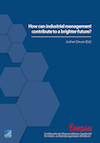Search


Bibtex
Cite as text
@Inbook{Kuhlang+Benter+Neumann,
Cite-key = "Kuhlang2023WGAB",
Year= "2023",
Volume= "Schriftenreihe der Wissenschaftlichen Gesellschaft für Arbeits- und Betriebsorganisation (WGAB) e. V.",
Pages= "35-53",
Journal = "WGAB",
Title= "MTM in Motion – Perspectives to Digital Work Design",
Author= "Peter Kuhlang, Martin Benter, Maria Neumann;
MTM ASSOCIATION e. V., MTM-Institute",
Doi= "https://doi.org/10.30844/wgab_2023_3",
Abstract= "The cost of production is a key factor for industrial companies. Labour costs are one relevant portion of these costs, especially for production sites with a high percentage of manual processes. Therefore, describing, analysing, and designing manual work processes in a systematic way is an important task in most Industrial Engineering departments.
There are multiple methods to describe and analyse work processes. Widely known methods include REFA, MTM and Work Factor. While there are multiple MTM methods to address the different types of production, one of the most established methods is MTM-UAS®. The most recent process building block system is MTM-HWD®. It describes work processes not only from a productive standpoint, but also includes ergonomic factors to assure productive and ergonomic work in one step. While the MTM systems can be used to systematically design work processes, they still require manual effort for data collection and interpretation. Due to this fact, not every company has the necessary.
One possibility to reduce this effort is the automatic interpretation of digitized human motion data. Motion data depicts human movements and postures and includes, for example, distances covered, joint positions or object interactions. One technology that is capable to generate this data is virtual reality. Thanks to the advances in the technology in recent years, it can be used in a variety of workplaces and with minimal training.
This article presents an approach how one can use the motion data of virtual reality tools to derive automated MTM-UAS® and MTM-HWD® analyses. Using VR technology thus reduces the analysis effort significantly and offers to expand the areas of application beyond its traditional domain. First, the article shows a workplace example that was modelled using a virtual reality tool. It then explains the necessary data to automatically derive MTM-analyses. It then shows the translation into a valid MTM-analyses.
The article concludes with a critical discussion and an outlook on how this approach can be transferred to other digital technologies. With such a transfer it is conceivable to design a higher number of workplaces in a productive and ergonomic way.",
Keywords= "digital human motion data, automated process analysis, MTM-UAS®, MTM-HWD®, MTMmotion®",
}
Peter Kuhlang, Martin Benter, Maria Neumann;
MTM ASSOCIATION e. V., MTM-Institute(2023): MTM in Motion – Perspectives to Digital Work Design. Schriftenreihe der Wissenschaftlichen Gesellschaft für Arbeits- und Betriebsorganisation (WGAB) e. V.(2023), S. 35-53. Online: https://doi.org/10.30844/wgab_2023_3 (Abgerufen 04.07.25)
Open Access
Abstract
Abstract
The cost of production is a key factor for industrial companies. Labour costs are one relevant portion of these costs, especially for production sites with a high percentage of manual processes. Therefore, describing, analysing, and designing manual work processes in a systematic way is an important task in most Industrial Engineering departments. There are multiple methods to describe and analyse work processes. Widely known methods include REFA, MTM and Work Factor. While there are multiple MTM methods to address the different types of production, one of the most established methods is MTM-UAS®. The most recent process building block system is MTM-HWD®. It describes work processes not only from a productive standpoint, but also includes ergonomic factors to assure productive and ergonomic work in one step. While the MTM systems can be used to systematically design work processes, they still require manual effort for data collection and interpretation. Due to this fact, not every company has the necessary. One possibility to reduce this effort is the automatic interpretation of digitized human motion data. Motion data depicts human movements and postures and includes, for example, distances covered, joint positions or object interactions. One technology that is capable to generate this data is virtual reality. Thanks to the advances in the technology in recent years, it can be used in a variety of workplaces and with minimal training. This article presents an approach how one can use the motion data of virtual reality tools to derive automated MTM-UAS® and MTM-HWD® analyses. Using VR technology thus reduces the analysis effort significantly and offers to expand the areas of application beyond its traditional domain. First, the article shows a workplace example that was modelled using a virtual reality tool. It then explains the necessary data to automatically derive MTM-analyses. It then shows the translation into a valid MTM-analyses. The article concludes with a critical discussion and an outlook on how this approach can be transferred to other digital technologies. With such a transfer it is conceivable to design a higher number of workplaces in a productive and ergonomic way.
Keywords
Schlüsselwörter
digital human motion data, automated process analysis, MTM-UAS®, MTM-HWD®, MTMmotion®

 Deutsch
Deutsch